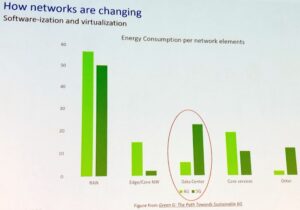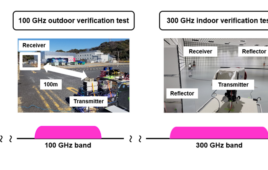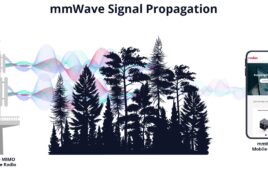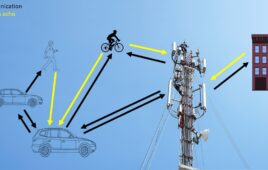October 2022 featured two conferences looking at 6G. The metaverse topped both but engineering and sustainability were featured, too.
Although 5G is still in carrier buildout and use cases outside of consumer are coming slowly, 6G research has been in place for several years. If we are to believe industry timelines, 6G will move into standardization in the second half of the 2020 decade and into deployment around 2030. What might 6G look like? That’s the topic of two 6G conferences held in October 2022.
The 6G Symposium, organized by 6G World (no relation to 5G Technology world or EE World) took place October 11 and 12 in Washington. NYU held its Brooklyn 6G Summit on October 25 and 26. in New York. 5G Technology World was in person at both.
On one level, marketers have already declared the undefined metaverse as something that will transform our lives by 2030. Talk of the merging of the human, physical, and digital worlds will supposedly create tremendous opportunities. “Digital twins,” computer models of everything from circuits to machines to entire cities, will theoretically provide us with ways to vastly improve the world and our lives. 6G will, according to the marketers and futurists, be the mechanism that will enable of this fantastical world. We’ll no longer talk about delivering more bits, but we’ll deliver experiences. 6G will make it all possible. Of course, some marketers claim 5G is already making that happen. I’ll believe it when I see it.
To make these marketing claims approach reality, engineers will have to research, specify, design, build, and test the underlying infrastructure – radios, networks, hardware, and software. We’ll have to prioritize interoperability, security, energy use, data rates, spectrum use, and a host of other issues. Said another way, we’ll have to prioritize everything. That’s the main takeaway from these two conferences.
Energy
Estimates are the 20% of all world emissions will come from telecom infrastructure and devices. We can’t let that happen.
“Sustainability is more than greenhouse gases,” said VMWare’s Colleen Josephson. That sustainability includes water used to cool datacenter servers. Datacenters, depending on size and location, can use hundreds of thousands to several million gallons of water each day. That’s not to mention the amount of electricity — and thus emissions — needed to pump and cool that water and power all those computers.
Josephson also noted that 2.4% of emissions come from ICT but will grow because of increased demand. Furthermore, she explained how networks are changing to distributed cloud architectures to reduce latency to the user through edge computing. All that software, running on COTS hardware, increases energy consumption in 5G.
Throughout both conferences, speakers reiterated the need for energy efficiency to be designed into 6G from the start. Energy efficiency starts at the circuit level with better power circuits, amplifiers, and processors. Circuit-level discussions didn’t arise in the “big picture” sessions nor in the more technical sessions or either conference.
Spectrum, or lack thereof
Everyone agrees that wireless communications will never have enough spectrum and that spectrum sharing will be necessary. Some spectrum sharing will have to be managed, such as in the case of CBRS. Some sharing should be possible between satellite and terrestrial use because of angle of transmission from satellite to Earth compared to terrestrial base stations.

6G Symposium panel on the convergence of computing and communications. L-R Martin Rowe, (EE World), Chonggang Wang (InterDigital), Vinay Kanitkar (Akamai), Clara Li (Intel), Geoffrey Tucker (NXP), Stephen Rose (IBM). Photo by Roger Nichols.
As 5G was developing, we heard (and still hear) about FR1 (sub 6 GHz) and FR2 (mmWave) frequencies, but nothing about frequencies from 7 GHz to 24 GHz. That’s changing with 6G discussions. Speakers at both conferences from the FCC and from other organizations now eye 7 GHz to 24 GHz use for both terrestrial and satellite telecom and internet communications. The FCC is paying particular attention on frequencies from 7 GHz to 16 GHz.
Joel Taubenblatt, Acting Wireless Bureau Chief, FCC told attendees in Brooklyn “We need to look at the7 GHz to 16 GHz band. We have to make spectrum sharing more common, as we’ve done with the 5.975 GHz to 7.125 GHz band.
On October 27, 2022 the FCC announced its intent to examine the repurposing of the 12.7 GHz to 13.25 GHz band for 5G and 6G. The FCC is also considering use of 12.2 GHz to 12.7 GHz for sharing between terrestrial 5G and satellite downlink for TV. These proposals could make and additional 1.25 GHz available for 5G and 6G.
Even if that happens, spectrum will still be in short supply. Current research into frequencies above 100 GHz is ongoing at NYU, Northeastern University, and other locations. Frequencies around 140 GHz are getting the most attention, although Northeastern professor Josep Jornet notes experiments showing reliable transmission distances of 2 km at 240 GHz is possible. Such a distance means that such frequencies can be used for backhaul, freeing lower frequencies for other use.
In Washington, Ericsson’s Ali Khayrallah declared “mmWave is a success, look at sports stadiums and the 2022 Super Bowl.” Outside of such venues, mmWave 5G is still not readily available and even if it is, does it matter?
While there’s still plenty of available capacity in the mmWave FR2 bands, some are concerned even with the addition of sub-terahertz frequencies. As this slide shows, there’s currently 10 GHz available under 275 GHz and it’s divided over three bands. That’s not as useful as having all 10 GHz in a contiguous band. (IMG_0885_mmWave_freq_chart)
Communications standards and regulations often focus on transmitters and the signals they send, looking at modulation, power, spectrum, and other parameters. Now, receivers are getting attention. Several speakers at both conferences noted that the FCC and others are looking at receiver specifications to improve spectrum use. Such receiver scrutiny should go beyond 6G radios to look at other receivers in the hope of preventing another aircraft altimeter controversy.
The digital divide
Another hope for 6G is that it will shrink the digital divide; some areas still can’t get wireless phone service nor internet access. That’s where satellite and fixed-wireless access (FWA) come in. In terms of FWA, the telecom news reports almost daily about T-Mobile attracting new FWA subscribers. “We’ve squeezed as much as we can from consumer phones,” said Mobile Experts’ analyst Joe Madden in Brooklyn.
Also in Brooklyn, Robert Jakubek from US Cellular gave everyone a reality check by highlighting the digital divide in rural areas. “We want to connect rural areas, he said. “We will do whatever brings in revenue and right now, that’s fixed wireless. Cost determines who we can reach. Running lines for power and fiber to reach one subscriber is expensive. The challenge today is to use small cells with solar panels for power.” US Cellular is using 5G Low-band and mmWave frequencies for FWA. Jakubek noted that customers can install low-band FWA themselves in about 15 minutes. Because of mmWave’s shorter range, home installation requires a technician to install an outdoor antennas.
The metaverse thing
Both conferences produced considerable talk about the metaverse, which some say is the melding of the physical world, the digital world, and the human world. “By 2030, yhe world will be transformed,” said a voice in a Nokia video that played in Brooklyn. What does that mean? Some call it the digital modeling of the physical world with human input. If we are to believe the hype, we’ll be holding holographic business meetings where we’ll feel as though we in the same room with others. We’ll have models of everything so we can try different scenarios and see the outcome. We’ll also have computing power closer to us to reduce latency, something the financial and manufacturing communities clamor for.
In addition to the metaverse, a Washington panel that I moderated, discussion focused on the convergence of computing and communications, something we’ve been hearing about for some 25 years. This “transformation” will require upgrades to radios and networks. In this panel, Intel engineer Clara Li spoke about an end-to-end compute-service plane and a data-service plane in addition to 5G’s communication service plane. This will create a “6G wide-area cloud” where computing power will reside wherever it’s needed. Li_wide-area-cloud_1005x480
InterDigital’s Chonggang Wang noted that security and trust will be essential components of 6G. To that end, he advocated for using blockchain technology to improve trustworthiness, accountability, and transparency.
Madden, who was featured prominently in both Washington and Brooklyn, summed up all of issues down to one: money. “If these technologies aren’t profitable, then nobody will use them.”










Tell Us What You Think!